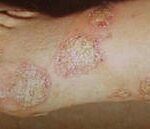Have you ever had a rash that perplexed you? Did you ever wonder why someone you know always seems to have a ‘red face’? Do you have a mole that has changed or worries you? If you answered yes to these questions, have a skin disease or know of someone who has one, hopefully these facts will help you understand some of the diseases that can afflict us and how they are treated and in some cases cured.
Rosacea
According to the National Rosacea Society, “Rosacea (pronounced roh-ZAY-sha) is a common but little-known disorder of the facial skin that affects an estimated 14 million Americans”; with most of them not knowing it is Rosacea.
Because of the red, acne-like appearance of Rosacea, it can become a psychological, social and even an occupational burden. The National Rosacea Society stated, “In recent surveys…nearly 70 percent of rosacea patients said their condition had lowered their self-confidence and self-esteem and 41 percent reported it had caused them to avoid public contact or cancel social engagements. Among rosacea patients with severe symptoms, nearly 70 percent said the disorder had adversely affected their professional interactions and nearly 30 percent said they had even missed worked because of their condition.”
Approximately 78 percent of Americans are still unaware of this disease even though the signs and symptoms are easily found by referring to a doctor (dermatologist), the Internet or even the library. Unfortunately the cause of rosacea is still unknown, but there is medical help available. As of August of this year; according to a news article on Web MD, there is a recent study published by Nature Medicine suggesting that overproduction of two inflammatory proteins results in abnormally high levels of a third protein, which causes rosacea’s symptoms.
Treatments for rosacea vary; sometimes depending on the intensity of your rosacea. The National Rosacea Society lists two treatment types with photos. There are topical treatments (applied like a cream to the skin) and treatments using a ‘pulsed-dye laser’ which uses a strong light emitting laser that pulses at set intervals.
If you are currently experiencing “redness on the cheeks, nose, chin or forehead; small visible blood vessels on the face; bumps or pimples on the face and/or watery, irritated eyes; seek professional help.
Psoriasis
Pronounced (sore-eye-ah-sis) is a non-contagious, “immune-mediated, genetic” lifelong skin disease; according to the National Psoriasis Foundation. They also report that 10 to 30 percent of people with psoriasis also develop psoriatic (sore-ee-AA-tic) arthritis, which causes pain, stiffness and swelling in and around the joints.
The National Institutes of Health states that “as many as 7.5 million Americans have psoriasis.
Even though doctors do not know the “exact” cause of psoriasis, they are aware this disease has a genetic factor and the immune response causes an overgrowth of skin cells. Psoriasis is easily diagnosed upon examination by a doctor. There are no special tests needed.
While there is no cure, there are topical (on the skin) and systemic (throughout the body) treatments.
There are several forms of psoriasis; according the National Psoriasis Foundation. These include the most common, Plaque psoriasis, along with Guttate (GUH-tate), characterized by small dot-like lesions, Pustular (PUHS-choo-ler), characterized by weeping lesions and intense scaling, Inverse; characterized by intense inflammation and Erythrodermic (eh-REETH-ro-der-mik); characterized by intense shedding and redness of the skin.
More commonly, psoriasis affects the knees, elbows, scalp and torso; but any part can be affected. It usually appears in the young; between the ages of 15 and 35; but, like the areas that it affects; it can occur at any age. Psoriasis is also known to have “triggers”; as noted by the National Psoriasis Foundation. These triggers can include injury to the skin, stress, some infections and drugs. Because dry skin can induce and aggravate the itching of psoriasis, it is recommended to keep it moisturized. There are also drugs that can be given to alleviate the itching symptoms of psoriasis. It is always best to discuss your options with your doctor.
Vitiligo
Most of us know of a very famous or even infamous person with this disease and if you don’t, where have you been? Holed up in a bunker for the last 30 years? Michael Jackson has reported in more than one interview he has this disease. Vitiligo is known as a melanocyte (the cells that make pigment) disorder. These melanocyte cells in the skin are destroyed which in turn causes the white patchy look and sometimes the hair that is located in those patchy areas become white.
Vitiligo does not have a known cause, but there are theories. According to medicine net, “there is strong evidence that people with vitiligo inherit a group of three genes that make them susceptible to depigmentation. The most widely accepted view is that the depigmentation occurs because vitiligo is an auto-immune disease-a disease in which a person’s immune system reacts against the body’s own organs or tissues.
It is reported as many as 65 million people may be afflicted with vitiligo. Half of the 1 to 2 million people in the United States that have vitiligo got it before they were 20; while most develop the disease before the age of 40. This disorder affects across all races and both sexes equally; although it is more noticeable on those with darker skin.
Vitiligo seems to be more prevalent in those that already have an auto-immune disorder; such as hyperthyroidism (overactive thyroid), alopecia areata (patches of baldness), pernicious anemia (a disorder characterized by low red-blood cells because of a failure in the body’s ability to absorb vitamin B12.) and adrenal cortical insufficiency (adrenal gland does not produce enough corticosteroid). Possibly, vitiligo is inherited. People whose parents have this disorder are more likely to also have vitiligo.
You may notice either a facial, segmental or generalized pattern. The facial pattern is limited to one or two areas, where as the segmental pattern appears on only one side of the body. Now, the generalized pattern happens symmetrically on both sides of the body. Diagnoses are by physical examination and the doctor may test you for the other auto-immune disorders mentioned previously; to be safe. Even though there is no cure for vitiligo, one way to help you feel more confident; especially as a woman; is to wear makeup that covers the vitiligo well. Another option is topical steroid therapy; which if applied early enough can help with re-pigmenting the skin. PUVA (Psoralen photochemotherapy) which is considered to be the most effective therapy for vitiligo (according to medicine net), but can be dangerous using certain drugs along with ultraviolet rays to re-pigment the skin. The patient has to be constantly monitored as sunburn and blistering can happen quickly. Depigmentation may be what Michael Jackson used as his therapy for vitiligo; although that cannot be confirmed. Depigmentation is exactly as it sounds. This involves fading of the remainder of the skin to give a more uniform appearance. The drug monobenzylether of hydroquinone is used and people who go through depigmentation have a tendency to be light sensitive. There are also surgical therapies which involve using different types of skin grafts.
There is extensive research currently going on and if you do have vitiligo, discuss all of your options with your doctor.
Skin Cancer
There are many other skin disorders, but I will mention one more; skin cancer; which is one of the most common types of cancer. Skin cancer is broken up into malignant and non-malignant; also referred to as melanoma and non-melanoma.
Melanoma is considered rare, occurring in approximately only 4 percent of cases. Unfortunately, even though it is rare, melanoma is known to be more deadly. Melanoma is not only treatable, but also curable, as long as it is detected and treated early.
Most of us know that melanoma can be caused by ultraviolet exposure (excessive sun exposure without sunscreen), but what many don’t know is that even tanning booths can cause unwanted exposure; especially to those with fair skin. Add in smoking, age (over 70), male and family history; you are at a greater risk for developing melanoma.
Melanoma is characterized by a mole that darkens, changes shape and sometimes even itches. Moles that change shape becoming irregular or larger than 6mm need to be investigated by a doctor. If you are in doubt, please seek the advice of a physician trained to recognize melanoma; this is not something you should put off.
Risk factors and symptoms of non-melanoma are similar to those of melanoma. Non-melanoma does not usually spread and is normally not life threatening. There are two more common types of non-melanoma; basal cell carcinoma and squamous cell carcinoma. Basal cell is recognized by a flat lesion or a wax-like bump; while squamous cell is recognized by a flat lesion with a scaly surface or a reddish bump. Treatments are pretty straight forward; they include cryosurgery which involves the freezing of the lesion, excisional surgery, which just means they cut it away; Moh’s surgery removes one layer at a time until the only layer that is left is the healthy layer and laser surgery.
The only way to confirm a diagnosis of malignant or non-malignant melanoma is by visiting your doctor and getting a biopsy of the area in question.
All diseases mentioned in the article are for information purposes only and not a substitute for visiting your doctor and seeking their medical advice. If you ever have a question about something that shows up on your skin, contact a physician, it could save your life.
Sources:
The National Rosacea Society; “All About Rosacea”
National Psorasis Foundation; “Frequently Asked Questions”
National Institutes of Health; “Vitiligo Symptoms, Causes, Treatments for Pigmentation Loss and Diagnosis” Medicine net
Unknown Author; “Skin Cancer” Skin Disorders A to Z



